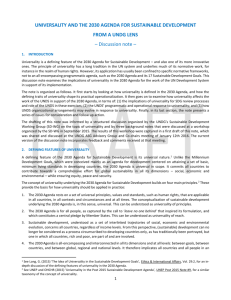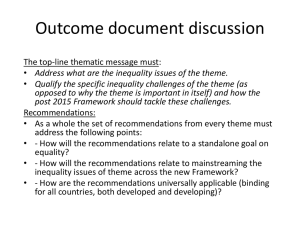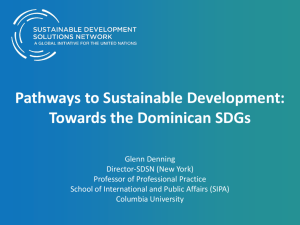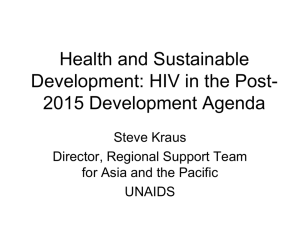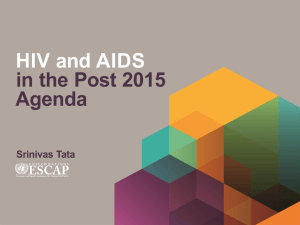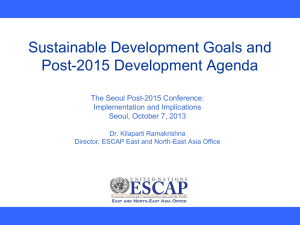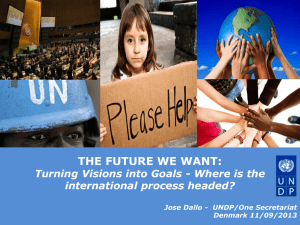Item 3b - Theory of Change Summary Paper 1.0 26 January
advertisement
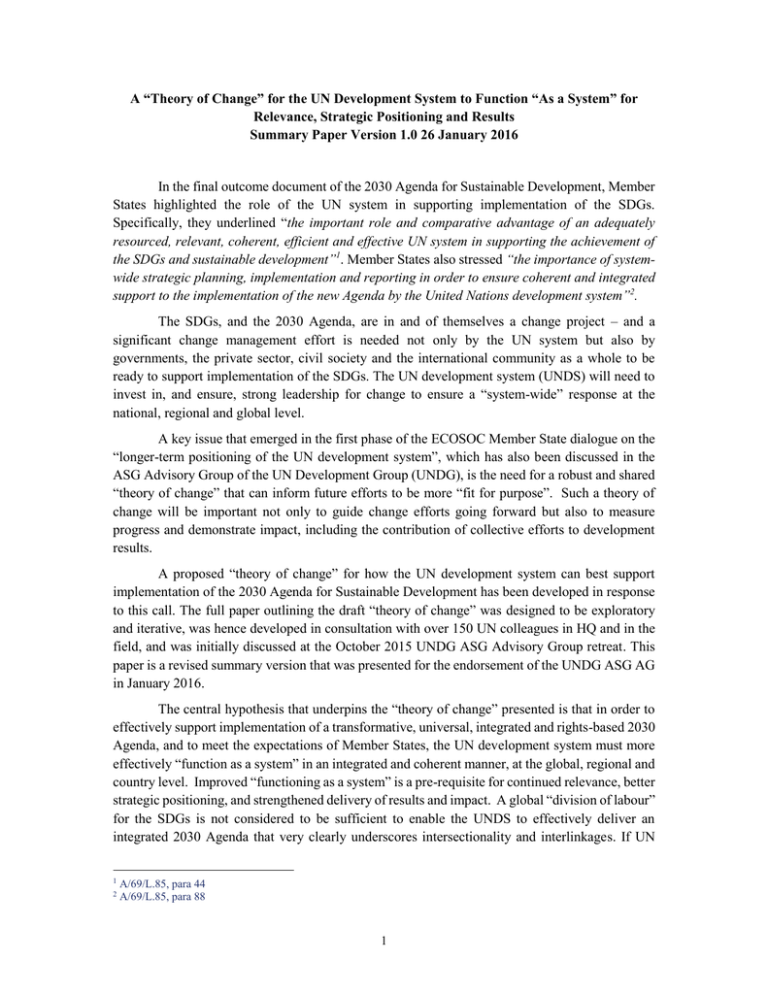
A “Theory of Change” for the UN Development System to Function “As a System” for Relevance, Strategic Positioning and Results Summary Paper Version 1.0 26 January 2016 In the final outcome document of the 2030 Agenda for Sustainable Development, Member States highlighted the role of the UN system in supporting implementation of the SDGs. Specifically, they underlined “the important role and comparative advantage of an adequately resourced, relevant, coherent, efficient and effective UN system in supporting the achievement of the SDGs and sustainable development”1. Member States also stressed “the importance of systemwide strategic planning, implementation and reporting in order to ensure coherent and integrated support to the implementation of the new Agenda by the United Nations development system”2. The SDGs, and the 2030 Agenda, are in and of themselves a change project – and a significant change management effort is needed not only by the UN system but also by governments, the private sector, civil society and the international community as a whole to be ready to support implementation of the SDGs. The UN development system (UNDS) will need to invest in, and ensure, strong leadership for change to ensure a “system-wide” response at the national, regional and global level. A key issue that emerged in the first phase of the ECOSOC Member State dialogue on the “longer-term positioning of the UN development system”, which has also been discussed in the ASG Advisory Group of the UN Development Group (UNDG), is the need for a robust and shared “theory of change” that can inform future efforts to be more “fit for purpose”. Such a theory of change will be important not only to guide change efforts going forward but also to measure progress and demonstrate impact, including the contribution of collective efforts to development results. A proposed “theory of change” for how the UN development system can best support implementation of the 2030 Agenda for Sustainable Development has been developed in response to this call. The full paper outlining the draft “theory of change” was designed to be exploratory and iterative, was hence developed in consultation with over 150 UN colleagues in HQ and in the field, and was initially discussed at the October 2015 UNDG ASG Advisory Group retreat. This paper is a revised summary version that was presented for the endorsement of the UNDG ASG AG in January 2016. The central hypothesis that underpins the “theory of change” presented is that in order to effectively support implementation of a transformative, universal, integrated and rights-based 2030 Agenda, and to meet the expectations of Member States, the UN development system must more effectively “function as a system” in an integrated and coherent manner, at the global, regional and country level. Improved “functioning as a system” is a pre-requisite for continued relevance, better strategic positioning, and strengthened delivery of results and impact. A global “division of labour” for the SDGs is not considered to be sufficient to enable the UNDS to effectively deliver an integrated 2030 Agenda that very clearly underscores intersectionality and interlinkages. If UN 1 2 A/69/L.85, para 44 A/69/L.85, para 88 1 Agencies, Funds and Programmes focus only on their own mandates and priorities, and not on how the UNDS can really maximize synergies at all levels, or do not sufficiently consider how individual entity contributions affect implementation of all SDG goals and targets, we will be less likely to succeed. At the same time, it is important to determine when it is most critical that the UNDS “functions as a system” – and when it is not. This proposed “theory of change” is therefore focused on how the UN development system can best collectively support delivery of the SDGs. Where the SDGs constitute the “what” that the UNDS will need to help to deliver, this “theory of change” focuses on the “how”, stressing that if the UNDS is to be more “fit for purpose”, change efforts must be much more purpose driven. The paper takes as its primary focus the UN development system, while noting the need to give further consideration to developing a theory of change across the pillars of the UN system. Past and current UN reform efforts, including the reforms introduced by UN SecretaryGeneral Kofi Annan in 1997, the “Delivering as One” initiative, and the 2012 QCPR, among others, contain underpinning assumptions about how change happens in the UNDS and how best to achieve it. Often previous reform initiatives have only been partially implemented, making it harder to assess success and impact. Lessons learned from these efforts can help inform the design of reform initiatives going forward. These include: the need to fully implement reform packages to maximize impact and results; to ensure change efforts are strategic, focused and well sequenced, and supported by appropriate instruments; and that targets and indicators for measuring progress are in place while still allowing for flexibility and experimentation. Further, while change efforts such as the “Delivering as One” initiative have to date largely been focused on the country level, there is a now need to consider whether greater focus on systemic change is needed. At the same time, structural change, while very important, must be reinforced by attitudinal and behavior change. Strong leadership and vision for change are critical. Key drivers of change in the UNDS have also been highlighted by external UN-watchers including in the context of the ECOSOC dialogue. There is a shared and emerging sense that change is often driven from outside the UN system, including by shifting funding patterns, changing mandates, the setting of international development goals, and governance arrangements. As external observers have noted, in a complex system like the UNDS, change is as often haphazard and accidental as it is deliberate and designed. Further, UN reform is not only a technocratic process, but is in the end dependent on political will and commitment of Member States and of the UN system itself. If the 2030 Agenda and the SDGs represent a key moment - potentially a “fourth shift” in the evolution of the UNDS and an imperative for change - the question then becomes: What else does the UN system need to do to be ready for the SDGs, and how much of this is “policy amenable” to deliberate design by the UN development system? This summary paper argues that the UN is best understood as a complex system, that is non-linear, interlinked and interdependent – and that different approaches to change are needed that are much more diversified, flexible and decentralized. Creating space for, and fostering, experimentation and innovation is key in this regard, and it will be important to facilitate strategic experimentation in the UNDS in support of the SDGs at all levels. Efforts to ensure greater coherence and integration in support of SDG implementation are already underway in many sectors. For example, individual governments are setting up national 2 coordination mechanisms for sustainable development and considering how best to ensure “whole of government” responses to the SDGs3. The OECD-DAC “Fit for the Future” initiative is looking at the core capabilities that DAC members will need in order to deliver effective development cooperation, as well as how best to adapt to the SDGs4. The World Bank has set out its approach to the 2030 Agenda, in a September 2015 paper, which highlights where the Bank intends to contribute, based on its comparative advantages5. Global partnerships such as Every Woman Every Child are also repositioning in light of the SDGs, with new partners, investments and financing mechanisms6. Devex and FHI’s “integrated development” initiative highlights the importance of leveraging interdependencies and addressing complex problems at a systems level in the context of the 2030 Agenda 7 . The UNDS can benefit from these approaches, including efforts to better measure results of integrated initiatives and show whether and when integration and collaboration offers added value – and when it does not. Against this backdrop, proposed elements for a “theory of change” for UN development system reform towards improved functioning “as a system” for relevance, strategic positioning and results include the following: (i) The context for, and underpinning factors and drivers, that determine change in the UNDS The context for the draft “theory of change” includes many of the factors outlined in the background papers for the first phase of the ECOSOC Member State dialogue8. The underpinning factors and drivers set the parameters for the work of the UNDS, and constitute the enabling – or inhibiting – environment for change. Funding is a critical driver, both of fragmentation – the predominance of bilateral, project based funding undermines efforts to be more coherent and integrated and promotes competition for resources – and also of coherence, including through the use of pooled funding mechanisms at global and country levels. As highlighted in the first phase of the ECOSOC dialogue, governance of the UNDS as a “system”, and the decisions of individual governance bodies of UNDS Agencies, Funds and Programmes, are not always consistent, impeding coherence and integration efforts. As the values and principles of the UN and the normative commitments made by Member States evolve, they drive change in the focus, and operations, of the UNDS, as do changes in UN system-wide and individual agency mandates. Internationally agreed development goals, including the MDGs, and now the SDGs, also drive change in the way the UNDS is funded and organized, as well as the UNDS’s priorities for delivery, and measures of success. Also important are changing perceptions and expectations of Member States, and their views about the role and function of the UNDS in the SDG-era, as well as political will and leadership of Member States, 3 See examples cited in https://undg.org/wp-content/uploads/2015/10/Mainstreaming-the-2030-Agenda-UNDGInterim-Reference-Guide-to-uncts-7-October-2015.pdf 4 See http://devpolicy.org/how-should-aid-agencies-evolve-views-from-developing-countries-20150323/ 5 See “ The World Bank Group Support For The 2030 Agenda For Sustainable Development” available at: http://siteresources.worldbank.org/DEVCOMMINT/Documentation/23693927/DC20150009(E)agendaforsd.pdf 6 http://www.everywomaneverychild.org/news-events/news/1141-un-secretary-general-announces-25-billion-in-initialcommitments-to-end-preventable-deaths-of-women-children-and-adolescents-by-2030 7 https://www.devex.com/news/pivoting-to-post-2015-proving-the-promise-of-integrated-development-86920 8 Available at http://www.un.org/en/ecosoc/qcpr/index.shtml 3 and governments at the country level. Finally, changes in the mandates and functions of other pillars of the UN system – peace and security, humanitarian and human rights, are also key, including changes in the leadership function at country level, structural reforms, financing, accountability and reporting, mandated by the UN Security Council and other governing bodies. (ii) Key strategies and tactics that contribute towards system-wide functioning and which are “design-amenable” by the UNDS itself These include the intermediate drivers as well as the inputs and investments that the UNDS currently makes – or will need to make - to bring about change, which are “design amenable” and within the direct influence of the UNDS. Political will and leadership at all levels of the UNDS and within Agencies, Funds and Programmes is a critical driver and a strategic investment for change. Having the right incentives in place to ensure leaders are accountable for, and invested in, change towards greater coherence and integration is critical, as is trust within and between agencies. A strong and adequately resourced coordination system that can act as the independent and trusted “backbone” for coordination and integration is also key. Organizational arrangements and architecture must support substantive coherence and integration, including effective and flexible coordination architecture and mechanisms at the global, regional and country level. Also important are dedicated strategic capacities, research and development, innovation, knowledge management and policy capacity available to the UNDS “as a system”, together with greater investment in change management for the system, supported by system-wide internal communication and awareness raising regarding the role of the UNDS in supporting implementation of the SDGs that would complement external communications efforts that also reach and influence UN staff. Staff capacity and mobility is key, as is investment in staff capacity for the new agenda. Systems leadership and capacities to work in a more coherent and integrated manner across the dimensions of sustainable development and the pillars of the UN system will be critical going forward, as will much greater staff mobility within the system. Also important is having in place a robust, coherent and flexible body of guidance, methods, tools and approaches, such as the Standard Operating Procedures for “Delivering as One”, the recently issued Guidance Note on Human Rights for UN Resident Coordinators (UN RCs) and UN Country Teams (UNCTs) and the recent interim guidance for UNCTs on support to Mainstreaming the 2030 Agenda, as well as strategic analysis, planning and programming instruments that promote and enable coherent and integrated approaches, with the ultimate aim of moving to “one strategic framework” for one country. Other critical elements include a common monitoring and evaluation system that enables joint measurement and reporting on progress towards integration and coherence; a strong and effective horizontal accountability system and strengthened incentives for leadership and staff to work collaboratively; and accelerated business operations and harmonization efforts at global, regional and country level, including mutual recognition of agency business practice. A number of these elements are already in place, in particular at the country level, through the “Delivering as One” (DaO) approach now adopted in some 50 plus countries, or are about to be rolled out like the revised Performance Appraisal Tool for UN RCs and UN Country Teams – the Assessment of Results and Competencies (ARC). However, some – such as investment in 4 change management, internal communication, and strategic capacity for the system – will require greater investment and/or scaling up, while others – such as a common M&E system for systemwide substantive and coordination results, are not yet fully in place. Investments will also need to be strengthened across the pillars of the UN system to ensure greater integration in leadership, analysis and planning, programming, financing, operations and coordination at all levels. (iii) Specific measures and approaches generated by these investments If the strategies, tactics and investments outlined above are in place, it is posited that they will lead to the following measures and approaches: shared vision and objectives for substantive work and coherence efforts at all levels; a clear understanding and definition of UNDS comparative advantages vis a vis other partners; shared metrics and indicators for success in “functioning as a system”; a common UN staff with shared capacity that identify as “UN staff”, and a motivated and expert UN workforce with the right incentives in place to drive collaboration; a UNDS that communicates “as One” both externally and internally in support of coherent and integrated support to SDG implementation; national ownership and oversight of the UNDS’s programming at the country level through the DaO approach; joint policy, planning and programming initiatives in place; development and use of joint financing instruments at all levels; joint measurement, monitoring and evaluation of results and impact, including common assessment and evaluation of the contribution of collective efforts to development results; joint accountability for and transparent reporting on results and impact at national, regional and global levels; and a single/common back office, common services, and co-location, where cost-efficient and cost-effective, even if incrementally in place starting at the country level. As noted above, existing examples of these measures and approaches are in place, both within the context of Delivering as One at country level, and at the global level. It will be important to build on these experiences and good practices going forward. (iv) Intermediate outcomes, higher-level outcomes and overall objectives. It is posited that these measures will contribute to the intermediate outcome of the UNDS functioning “as a system” for greater relevance, improved strategic positioning, results and impact. This will enable the UNDS to deliver its key priority functions in an integrated and coherent manner in the SDG era. If achieved, this will result in improved delivery and impact of UN support and services; a stronger evidence base for system-wide results and impact; and improved UN-wide “branding” and image. This will also lead to, and be demonstrated by, increased government and stakeholder satisfaction, improved perceptions of the UNDS among external stakeholders, increased pride and satisfaction among UN leadership and staff, and a sense of common UN identity. Ultimately, this will enable the UNDS to more effectively contribute to the implementation and monitoring of the 2030 Agenda and support progress towards achieving the SDGs. (v) Key risks and assumptions There are some important caveats and risks to the draft “theory of change” outlined above. These include both risks of changing – and of not changing – as well as potential unintended consequences of reform. There is a risk of change fatigue at all levels, and resistance to change, while at the same time, not changing also carries risks that may potentially impact the reputation, 5 positioning and funding of the UNDS. There is a perceived risk of loss of diversity, and constrained individual agency mandates and branding, as a result of efforts to ensure greater integration and coherence. There is a risk that coherence and integration leads to “lowest common denominator” decision-making – constraining innovation, and undermining strategic vision and direction. Strong horizontal accountability may also run counter to vertical accountability, leading to difficulties with individual Agency governing bodies and stakeholders. Change in the UNDS is often personality driven, and impacted by turnover in leadership. Investment in change at all levels is needed to engage mid-level and national staff, together with accountability mechanisms that promote coherence and more effectively balance agency-specific incentives and accountability. Increased investment costs are associated with change, in particular in the start-up phase, noting however that there are also costs associated with maintaining the status quo, for example the transaction costs associated with slow progress on harmonization of business practices. Change efforts must demonstrably lead to lower transaction costs over time. There is a risk of being overly prescriptive and bureaucratic, focusing too much on getting the right guidance and tools in place – and too little on shared values and principles that can support behavior change and motivate leadership and staff. Raising the level of ambition – and stretching the appetite for change – are key, but so are realism, pragmatism, and getting the sequencing of change initiatives right. Even if the UNDS is able to accelerate change efforts to function more effectively in an integrated and coherent manner, integration across the pillars of the UN system may remain limited. Finally, there is a clear risk that the underlying factors and key drivers outlined above will undermine efforts of the UNDS to more coherently function as a system. Funding and governance arrangements that support rather than impede coordination and integration are particularly critical. The role of Member States in setting the parameters for change, and approving and supporting reforms, is central in this regard. Linked to this, some key assumptions that underpin the “theory of change” include that: the UNDS is able to overcome "change fatigue" and motivate leadership and staff; individual Agencies and leaders and staff at all levels are willing and incentivized to “take off their hats” and see their careers and future in the UN system as in part dependent on the extent to which they work towards integration and coherence; there is political will and commitment to address change at the global level, as well as greater space and support for innovation, and increased “risk appetite” and support for risk-takers; the UNDS is able to effectively manage diversity while clearly identifying where coherence and integration best add value and maximize impact; vertical and horizontal accountability mechanisms are in place that are mutually supportive and reinforcing; existing mandates and modalities for change - such as the current QCPR and the SOPs for “Delivering as One” - are fully implemented; opportunities for integration across the pillars of the UN are recognized, prioritized and effectively leveraged; and resources are available and invested in support of change. Further discussion is needed to better understand the impact of different drivers of change at the country, regional and global level. Aspects such as risk mitigation, and development of targets and indicators to measure progress, also require further elaboration. 6 Implications of this proposed “theory of change” point to areas where the UNDS has tended to under-invest to date, such as change management and internal communication in support of reform; the need for much more “test and fail” experimentation; and the need to shift from a “command and control” approach, to change that is more purpose and values driven. Strategically, it will be imperative to embrace complexity, promote integration and coherence while also leveraging the rich diversity of the UNDS, and advance both systemic change and country level experimentation at the same time. Alternative hypotheses may also need to be explored and tested, such as the proposition – not supported by this paper - that a clear cut division of labor between UN agencies would be sufficient to enable the UNDS to help deliver the SDGs. Measuring progress, in particular the contribution of collective efforts to development results, will also be key going forward, including to inform both the ongoing work of the UNDG and the development of the 2016 QCPR. Priorities for change Looking forward, to drive the change that is needed, the UNDS will need to continue to implement the priorities already agreed by the UNDG, including the roll out of “Delivering as One” and strengthening investment in the UN RC system. Additional critical areas for greater investment also need to be considered. These include the following: i) Funding – while funding remains the preserve of contributing partners, the UNDS should do all in its power to ensure financing mechanisms are in place, and are promoted and used, that can really help drive coherence, and advocate with donors to use these to the full extent possible. This includes pooled funding mechanisms at the global, regional and country level. ii) Leadership – accelerating efforts to ensure that the selection, capacity building, performance assessments and incentives, and support systems available to UNDS leaders - UN RCs and UNCTs as well as other leaders in the system - really drive and support coherence efforts. iii) Capacities and mobility of staff – a strong push is needed to ensure that Agencies, Funds and Programmes, and UNCTs, really have the right capacities in place for the SDG era, that the right incentives are in place to support coherence, and that staff mobility is encouraged, incentivized and rewarded to the fullest extent possible. iv) Strategic capacity – not only for the UNDS, but for the UN system as a whole to think, plan, strategize, assess and evaluate “as a system”. v) Change management – investment in change management capacity for the UN system in support of the SDGs and integration, building on existing system-wide capacities in UNDOCO, UNSSC, drawing in/on Agency change management capacity as needed, and including internal communications capacity to support behavior change communication to UN staff. vi) Shared metrics – developing common targets and indicators for both the “what” and the “how” at the global and country level including clear timeframes and sequencing of efforts. 7 vii) Evidence – much better, more robust and compelling evidence is needed to demonstrate the contribution and value-added of “functioning as a system” to development impact and results. Joint evaluation, joint audits, and joint donor assessments are all key in this regard. Many of these areas for investment are also relevant for other actors in the context of the 2030 Agenda. As this paper has argued, and as UN Secretary-General Ban Ki-Moon so clearly highlighted in his speech to the Sustainable Development Summit, in the SDG era “we can no longer afford to think and work in silos.”9 At the October 2015 UNDG ASG Advisory Group retreat, participants discussed how best to take forward a number of these critical areas, including much greater use of joint financing and investment strategies to help drive and support coherent responses, promoting transformative leadership as a key accelerator for driving change including at country level, and greater support to innovation and experimentation at all levels in support of the 2030 Agenda. To this point, the following actions have been prioritized going forward, as summarized in the discussion note prepared for the UNDG Principals meeting in November 2017: integration of the development, humanitarian, human rights and peacebuilding agendas, with a strong focus on integrated planning; joint programming underpinned by new UNDAF guidance and full implementation of the SOPs for “Delivering as One”; accelerated high performing and common business practices; joint financing and investment strategies to underpin joint programming at global and country level; and leadership as an accelerator for an effective UN development system. In addition to the above, it is recommended that going forward the UNDG also prioritize other areas identified in this paper for greater attention and investment, including much greater use of incentives and performance management measures to drive greater integration, better utilization of common change management capacities and development of shared metrics for success. Further, it is recommended that a broader theory of change be developed for the UN system as a whole, and that an appropriate process be identified for this, under the auspices of the CEB and in close consultation with the UN Secretariat and its entities. In addition, it is suggested to develop selected key indicators for the outcomes, measures, and strategies set out in the proposed theory of change that can be used by UN Country Teams and the UNDG to measure progress towards better “functioning as a system”. Given the central importance of Member States in driving and supporting change, the UNDG will also need to continue to invest in concerted advocacy with Member States to provide consistent and coherent guidance and financing of the UNDS going forward. Finally, it will be important to regularly review this proposed “Theory of Change” both to ensure its continued relevance as well as its usefulness and effectiveness in helping set key UNDG strategic priorities in support of implementation of the 2030 Agenda for Sustainable Development. 9 Secretary-General Ban Ki-moon, General Assembly, 25 September 2015, Remarks at Summit for the Adoption of the Post-2015 Development Agenda http://www.un.org/apps/news/infocus/sgspeeches/statments_full.asp?statID=2749#.Vi6e6G79l2E 8 Intermediate outcomes Proposed Theory of Change UNDS effectively contributes to implementation and monitoring of the SDGs at all levels - and ultimately to progress towards achieving the SDGs Hypothesis: functioning “as a system” will lead to continued relevance, improved strategic positioning and strengthened results and impact of the UNDS in support of the SDGs Improved delivery of UN support and services Improved evidence base for system-wide results and impact Improved UN-wide "branding" and image Increased government and stakeholder satisfaction and improved perceptions of the UNDS Integrated and coherent delivery of key priority functions in the post 2015 era: policy and normative support; capacity development & SSC, leveraging and convening role, integrated development and humanitarian support Functioning as a system for greater relevance, strategic positioning and results and impact Increased pride and satisfaction of leadership and staff, sense of common UN identity Assumptions: The UNDS is able to overcome "change fatigue" and motivate staff Individual agencies (leaders and staff) willing and incentivized to “take off their hats” to function more effectively “as a system” There is political will and commitment to address change at the global level, Space and support for innovation, increased “risk appetite” and support for risk-takers UNDS able to manage diversity without reinforcing fragmentation and competition Vertical & horizontal accountability mechanisms in place that are mutually supportive & reinforcing Existing mandates and modalities for change fully implemented. Opportunities for integration across the pillars of the UN recognized & effectively leveraged. Resources are available and invested in support of change. Measures and approaches Strategies and tactics Shared vision and objectives Political will and leadership, and trust, at all levels Clear understanding and definition of UN comparative advantages Strong, well-resourced coordination system, (UN RC system, RCO, UNDOCO) Shared metrics and indicators for success Organizational arrangements and architecture for coherence Political will and leadership of Member States Common UN staff common capacity, motivated and expert workforce Strategic capacity - R&D, innovation, knowledge management & policy capacity for "the system" UNDS funding and assessment (by donors) Communicating as One externally and internally Investment in change management supported by internal communication and awareness raising Governance arrangements National ownership and oversight Staff capacity and mobility and investment in capacity building UN values and principles and normative commitments Joint policy, planning and programming Flexible guidance, instruments, methods and tools, including the SOPs for DaO UNDS and individual Agency mandates, including the QCPR, new entities such as UNAIDS and UN Women Joint financing instruments Strategic analysis, planning and programming instruments that enable coherence and integration IADGs including the SDGs Joint measurement, monitoring and evaluation of system-wide results and impact Common M&E system Change in the other pillars of the UN system Joint accountability and reporting Common accountability systems and incentives Single back office, common services and colocation where cost efficient and cost effective Accelerated usiness operations and harmonization efforts Underpinning factors and drivers of change Changing external circumstances Higher level outcomes
